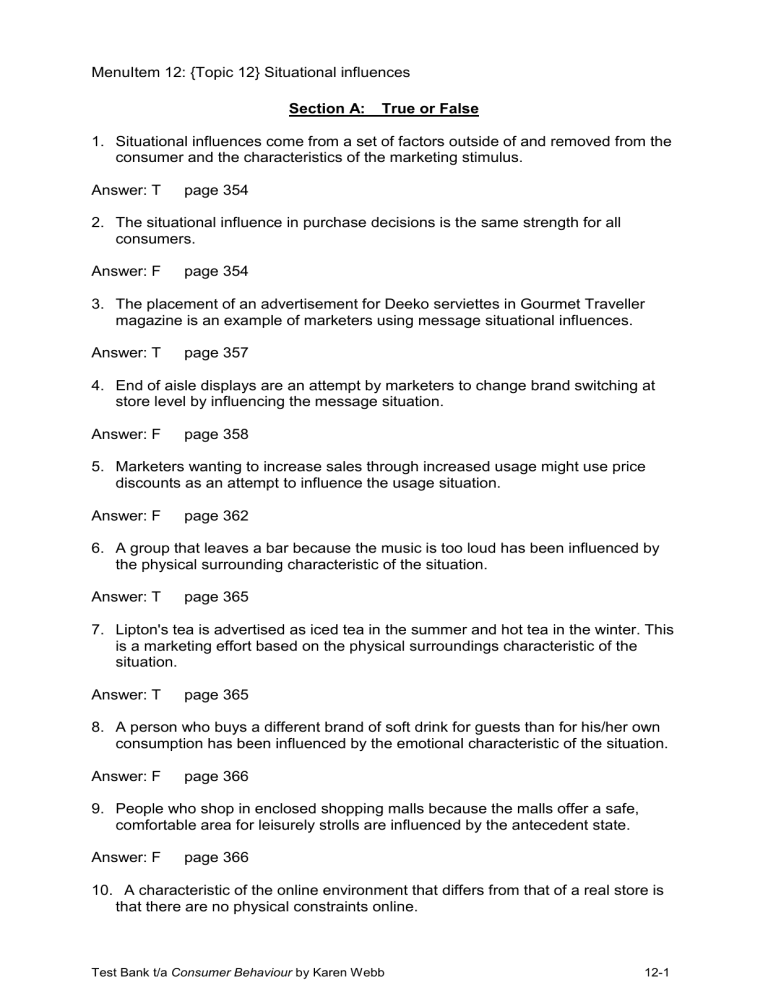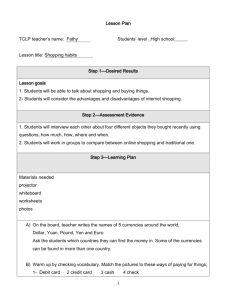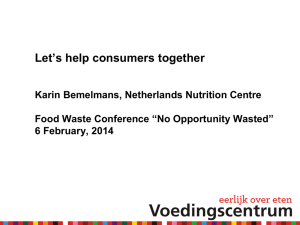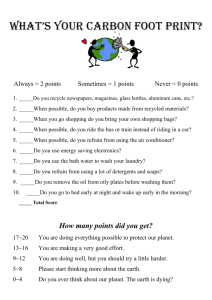Section A: True or False

MenuItem 12: {Topic 12} Situational influences
Section A: True or False
1. Situational influences come from a set of factors outside of and removed from the consumer and the characteristics of the marketing stimulus.
Answer: T page 354
2. The situational influence in purchase decisions is the same strength for all consumers.
Answer: F page 354
3. The placement of an advertisement for Deeko serviettes in Gourmet Traveller magazine is an example of marketers using message situational influences.
Answer: T page 357
4. End of aisle displays are an attempt by marketers to change brand switching at store level by influencing the message situation.
Answer: F page 358
5. Marketers wanting to increase sales through increased usage might use price discounts as an attempt to influence the usage situation.
Answer: F page 362
6. A group that leaves a bar because the music is too loud has been influenced by the physical surrounding characteristic of the situation.
Answer: T page 365
7. Lipton's tea is advertised as iced tea in the summer and hot tea in the winter. This is a marketing effort based on the physical surroundings characteristic of the situation.
Answer: T page 365
8. A person who buys a different brand of soft drink for guests than for his/her own consumption has been influenced by the emotional characteristic of the situation.
Answer: F page 366
9. People who shop in enclosed shopping malls because the malls offer a safe, comfortable area for leisurely strolls are influenced by the antecedent state.
Answer: F page 366
10. A characteristic of the online environment that differs from that of a real store is that there are no physical constraints online.
Test Bank t/a Consumer Behaviour by Karen Webb 12-1
Answer: T page 373
Section B: Multiple Choice
Question 1
The situation is: a) The marketing stimulus, the consumer, and the environment b) A set of factors outside of and removed from the consumer and the characteristics of the marketing stimulus c) Te set of factors that includes the attributes of the environment and the marketing stimulus, but excludes the attributes of the individual d) All those attributes of the consumption environment that do not directly affect the consumption process
Answer: B page 354
Question 2
In order to utilise situational influences, a marketer must be able to understand: a) The consumer's needs and motives b) The strength of the situational influence c) When the situational influence occurs d) b and c only
Answer: D page 354
Question 3
The trend of marketers paying movie makers to include their products as props in the movie, is using the _______________ situation to influence purchase decisions. a) Message b) Purchase c) Social d) Usage
Answer: A page 357
Question 4
Art galleries offering customers wine and nibbles is an example of the gallery marketers using the __________________ situation. a) Message b) Purchase c) Social d) Usage
Answer: B page 358
Question 5
Test Bank t/a Consumer Behaviour by Karen Webb 12-2
Supermarkets use situational influences to try to influence the volume of purchases by: a) Increasing the level of lighting b) Filling the isles with clutter c) Playing slow music d) Increasing the number of checkouts
Answer: C pages 358 & 365
Question 6
The provision of sales support material such as brochures to retailer sales staff is an example of marketers trying to influence the _______________ situation. a) Message b) Purchase c) Shopping d) Usage
Answer: B page 358
Question 7
Westfield has recently provided clusters of lounge chairs and couches set on rugs throughout their centres in an attempt to increase the value of the centres to customers whose motive for shopping is: a) Financial b) Pleasure c) A chore d) Loyalty
Answer: B page 359
Question 8
Radio Rentals offer the latest electronic and white goods products on a rental basis, rather than purchase, in an attempt to attract customers whose motive for shopping is: a) Financial b) Pleasure c) A chore d) Loyalty
Answer: A page 359
Question 9
The David Jones store card, offering reward points to users, rewards customers whose motive for shopping is:
Test Bank t/a Consumer Behaviour by Karen Webb 12-3
a) Financial b) Pleasure c) A chore d) Loyalty
Answer: D page 359
Question 10
Small suburban supermarkets, which have a smaller range than larger supermarkets, but have parking outside the door and fewer customers, are likely to appeal to customers whose motive for shopping is: a) Financial b) Pleasure c) A chore d) Loyalty
Answer: C page 359
Question 11
Stores such as Target and Myers which choose layouts that rarely include straight aisles from front to back are trying to influence customers whose motive for shopping is: a) Financial b) Pleasure c) A chore d) Loyalty
Answer: C page 359
Question 12
A ‘brand experience’ means: a) The way customers connect with a brand at an emotional level b) The way a customer uses a brand c) Customers have a chance to try the brand through sampling d) The way a marketer promotes the brand
Answer: A page 360
Question 13
When introducing a new product, marketers are best advised to create promotions showing the _________________________ situation. a) Message b) Purchase c) Shopping d) Usage
Test Bank t/a Consumer Behaviour by Karen Webb 12-4
Answer: D page 361
Question 14
The usage situation deals with: a) How the product is purchased b) Who influences the product purchased c) How we communicate to consumers about consumption d) How and when the product is consumed
Answer: D page 361
Question 15
Kellogg’s ran advertisements at the beginning of winter showing consumers enjoying
Cornflakes with warm milk. This is an example of the marketer trying to influence the
_____________________ situation. a) Message b) Purchase c) Shopping d) Usage
Answer: D page 362
Question 16
Cool colours, such as blue and green, are more appropriate: a) For store windows, entrances, and POP displays b) When customers are making repeat purchase decisions c) Where customers face tough purchase decisions d) a and c only
Answer: C page 365
Question 17
The estimated gross margin of restaurants playing slow background music is
___________________ that of restaurants playing fast background music. a) Double b) Less than c) The same as d) More than
Answer: D page 365
Question 18
A fast food restaurant would be recommended to play: a) Fast background music
Test Bank t/a Consumer Behaviour by Karen Webb 12-5
b) Soft background music c) No background music d) Contemporary background music
Answer: A page 365
Question 19
A flower shop would be best advised to paint the walls: a) Yellow b) Red c) Blue d) Brown
Answer: A page 365
Question 20
Playing fast, up-beat music in a shop will make customers feel: a) Happy and lengthen shopping time b) Anxious and lengthen shopping time c) Happy and shorten shopping time d) Anxious and lengthen shopping time
Answer: C page 366
Question 21
Seasonal conditions will influence purchase decisions of: a) White goods b)
Women’s fragrances c) Artworks d) Men’s fragrances
Answer: B pages 365 & 368
Question 22
The social situation would have the greatest impact on the choice of a dessert for: a) Everyday dessert b) A business dinner gathering c) Something to eat while studying d) Something to eat while watching TV
Answer: B page 366
Question 23
Momentary moods or conditions are situational influences known as:
Test Bank t/a Consumer Behaviour by Karen Webb 12-6
a) Personality states b) Physical surroundings c) Antecedent states d) Social surroundings
Answer: C page 366
Question 24
We exhibit different purchase behaviour when in different moods or situations because of our: a) Personality states b) Physical surroundings c) Antecedent states d) Social surroundings
Answer: C page 366
Question 25
A characteristic of the online environment that differs from that of a real shop is that: a) There are no physical constraints b) There are no mental constraints c) There is more interaction d) There is more variety
Answer: A page 373
Section C: Short Answers
Question 1
What factors do marketers need to understand in order to manipulate situational influences?
Answer: page 354
In order to manipulate situational influences, marketers must understand:
• the types of situations and how they influence behaviour
• how different situations affect consumers
• how strong the situational influence is.
Question 2
What is the message situation and what is the main marketing decision associated with it?
Answer: pages 354-357
The message situation involves both the setting in which the consumer receives the message and other communication variables, such as the message source and content.
Test Bank t/a Consumer Behaviour by Karen Webb 12-7
Choice of advertising media is one of the main marketing decisions involved in the message situation.
Question 3
What is the purchase situation and why do marketers try to understand how purchase situation influences buying behaviour?
Answer: page 358
The purchase situation is the setting or the environment in which the consumer acquires the actual product. It is the environment in which goods and services are actually purchased. Marketers attempt to understand the way in which the purchase situation influences buying behaviour because they have an enormous amount of control over the stimuli in the purchase setting. The marketer cannot control the way that consumers respond to these stimuli, yet research can guide marketing decisions to best utilise the purchase situation.
Question 4
What are the different motives that guide shopping behaviour?
Answer: page 359
Financial or economic motives
This motive causes customers to maximise value for money. These shoppers look for the best de al they can get. It does not really include customers who go ‘sales shopping’, as these people are more likely to be motivated by the ‘chase’ for a bargain. People motivated by economic factors are more likely to shop with a specific goal in mind.
Shopping for pleasure
Some people enjoy the shopping experience and many large suburban shopping centres cater for this need.
Shopping is a chore
There are many people who perceive shopping as a chore. It is not enjoyable and they want to get it over with as soon as possible.
Store loyal shopper
Some people like to shop at the same stores as they have a loyalty to the store for a particular reason. It might be due to the excellent service or rapport with staff. It could be that the store provides a consistently good range and value for money, or it may simply be a matter of habit!
Question 5
Do consumers have the same shopping motives for all purchase decisions they are involved in?
Answer: page 361
No. Each of these motives may also apply in varying degrees of strength, depending on the classification of goods and involvement level of the purchase. For example,
Test Bank t/a Consumer Behaviour by Karen Webb 12-8
some people may find grocery shopping a chore, but they love looking at shopping goods. Someone else might devote a lot of time to sale shopping, but may not spend a lot of time shopping at other times.
Question 6
What factors contribute to the shopping experience?
Answer: page 362
Factors include:
excitement
social environment
recreation
bargain shopping vs. shopping for a specific item
physical environment.
Question 7
What is the usage situation, and how do marketers use it in communications?
Answer: pages 361-362
The usage situation is the setting in which the product is consumed or used.
Marketers often show products in a usage situation. For example, many food products are demonstrated in ‘slice of life’ advertisements. This means that the advertisement shows the product being used in a real-life setting. This might be in usage situations such as picnics as well as dinner parties and special occasions.
Showing products in usage situations shows consumers how the product can be a part of their everyday lives.
Question 8
Explain why large department stores such as David Jones might create different atmospheres for different parts of the store.
Answer: page 365
Multi-level David Jones flagship stores in capital cities use atmosphere to great effect. The street level of the store is visited by people browsing or wandering through at lunch time. The layout is a traditional retail environment with table displays, ‘sale’ items and some lower involvement items. This environment is loud and busy compared to the store’s high fashion levels. On these levels the pace is slower, the lighting more subdued and the decor somewhat more luxurious. The music is also generally a classical style.
Question 9
Explain how a shopper’s mood might influence their shopping behaviour, and how marketers can manipulate mood.
Answer: page 366
Test Bank t/a Consumer Behaviour by Karen Webb 12-9
Mood can influence shopping behaviour. A consumer who is in a good mood is more likely to evaluate positive shopping experiences as better and vice versa. If a positive emotion can be created, a consumer is more likely to respond favourably. This is why many shops play upbeat and happy music. Store lighting can convey a sense of cleanliness and brightness. Marketers can influence consumers’ emotions through the use of using colours, music, merchandising, rewards, store layout and lighting.
Question 10
What does the term ‘antecedent states’ mean?
Answer: page 366
Antecedent states are influences that exist and influence behaviour at a particular time and in a particular situation, but they may not influence behaviour across all situations. For example, shopping behaviour will be different if you are in a good mood as opposed to being tired and cranky.
Section D: Essay Questions
Question 1
Discuss the marketing implications of the message situation as an influence in purchase decisions. Use examples to illustrate your answer.
Answer: pages 354-358
The message situation involves both the setting in which the consumer receives the message and other communication variables, such as the message source and content.
Choice of advertising media is one of the main marketing decisions involved in the message situation. Advertisers often place advertisements in programs of a tone similar to their message. For example, a business services company would be likely to advertise during Business Sunday, and Deeko serviettes advertised their fashion range in an Asian cooking ‘special’ in a food magazine. The advertisement was tailored specifically for the media it appeared in. If this advertisement had appeared in another form of print media, the creative strategy may have been different, focusing on the brand itself.
When considering the communication situation, it is also useful to think about communication forms other than advertising. For example, a company that sponsors a popular sporting team gets exposure through indirect methods such as on players’ clothing and other signage. The company would also get exposure if a player is photographed or interviewed on television wearing a jersey with the company’s name on it. Some teams are also known by the sponsor’s name, for example the Vodafone
Wallabies. Event sponsorship may also gain similar coverage, such as the Tooheys
Melbourne Cup in horse racing, or the national cricket competition, the Pura Cup
Cricket. Marketers use sports promotions to communicate with a target audience in the context of an actual event.
Question 2
Test Bank t/a Consumer Behaviour by Karen Webb 12-10
Discuss the marketing implications of the purchase situation as an influence in purchase decisions. Use examples to illustrate your answer.
Answer: page 358
The purchase situation is the setting or the environment in which the consumer acquires the actual product. It is the environment in which goods and services are actually purchased. Marketers attempt to understand the way in which the purchase situation influences buying behaviour because they have an enormous amount of control over the stimuli in the purchase setting. The marketer cannot control the way that consumers respond to these stimuli, yet research can guide marketing decisions to best utilise the purchase situation.
Most research on the topic of environmental influences in the purchase situation focuses on a physical purchase situation, such as in a retail outlet. However, with the increasing level of Internet purchasing, marketers must also consider the dynamics of the online purchasing environment. Many companies adopt strategies that encourage brand switching at store level. In the case of consumer durable goods such as televisions, sales staff can influence the purchase situation and thus buying behaviour.
Many researchers have confirmed that shopping behaviour is influenced by the atmosphere in the retail environment. Consumer researchers who have investigated retail shopping behaviour have also found significant relationships between the emotional state of the consumer and situational factors such as time spent in the store, propensity to make a purchase, and satisfaction with the experience. Positive relationships have been identified between mood states and how shoppers perceive the environment of the shopping experience. Mood also influences how much is spent and the amount of time spent in a particular store.
The 2003 A.C. Neilsen Grocery Reports highlighted research indicating that the majority of grocery shoppers actively look for specials. In-store displays are often more successful than discounts in generating incremental sales. This is most likely due to the perception of items being ‘on special’. The research also indicates that the majority of shoppers tend to be brand loyal, so bonus packs and special pricing tend to reward existing customers, rather than encouraging brand switching.
Question 3
Discuss the marketing stimuli that marketers can use to create or change the situational influence on purchase decisions.
Answer: pages 365-366
PHYSICAL SURROUNDINGS
These can include music, colour, merchandising, store layout and ambience. The online environment is less dynamic than the physical environment. Marketers can use colour, music and movement on a website, but not to the extent of the real retail environment.
MUSIC
Music has a definite influence over behaviour. Fast music puts customers in a happier mood, but makes them move faster through a store. Retailers such as supermarkets would prefer customers to take their time and pick up as many items
Test Bank t/a Consumer Behaviour by Karen Webb 12-11
as possible. Slower music makes customers take more time. Music has also been successfully used to curb anti-social behaviour in groups loitering at railway stations and shopping centres.
COLOUR
Colours influence behaviour in different situations. Warm colours attract attention, colours such as red represent passion and emotion, and cooler colours such as sky blue and green are more calming and soothing. Sale signs tend to be mostly red because red is attention-getting and exciting and stimulates the senses. Detergent packaging tends to be in ‘clean’ but bright colours such as blue, green or yellow.
ATMOSPHERE
This involves the physical surroundings of the situation. For example, you might spend 1 or 2 hours in a Pizza cafe, compared with 3 or 4 hours in a more exclusive up-market restaurant. You would wear different clothes to each venue and you would expect different service, lighting and music in each venue.
Multi-level David Jones flagship stores in capital cities use atmosphere to great effect. The street level of the store is visited by people browsing or wandering through at lunch time. The layout is a traditional retail environment with table displays, ‘sale’ items and some lower involvement items. This environment is loud and busy compared to the store’s high fashion levels. On these levels the pace is slower, the lighting more subdued and the decor somewhat more luxurious. The music is also generally a classical style.
WEATHER
Weather influences shopping behaviour. In Australia, hot weather causes shoppers to visit shopping centres; in colder climates, such as Canada and UK, consumers also visit shops when it is very cold. The temperature and rain influence behaviour, yet factors such as humidity do not.
Seasonality also influences decision making. Obvious examples of seasonal products are summer and winter clothing, swimming pools and ice-cream.
THE SOCIAL ENVIRONMENT
The presence of others is a situational influence which can have an impact on your behaviour. When we are with others, we tend to comply to group norms and expectations. We are likely to make different decisions when we are shopping for clothes by ourselves compared to shopping with friends. A salesperson’s suggestion that a garment ‘looks great on you’ might influence a person to choose something they wouldn’t normally buy.
Consumers might drink Tooheys beer at home but drink Crown Lager when out to dinner with friends, and wear a plain track top at home but then put on a brand label top, such as Nike, when going out somewhere.
DECISION TIME
The time we have available for decision making and consumption will influence our buying behaviour. If time is limited, we tend to look for convenience goods. Some marketers have created products that specifically address the needs of time poor consumers. For example, some McDonald’s outlets offer breakfast and dessert menus. In the late 1990s, the flavoured milk brands Dare and IC were targeted specifically to men as a morning drink instead of coffee or Coca-Cola.
Test Bank t/a Consumer Behaviour by Karen Webb 12-12
IMPORTANCE OF THE DECISION
The importance of the purchase decision influences consumer behaviour in a number of ways. Products such as milk and bread are routine purchases that don’t require a great deal of thought and search, but a wedding outfit or special gift is of great importance to the consumer.
EMOTIONAL INFLUENCES
Mood can influence shopping behaviour. A consumer who is in a good mood is more likely to evaluate positive shopping experiences as better and vice versa. If a positive emotion can be created, a consumer is more likely to respond favourably. This is why many shops play upbeat and happy music. Store lighting can convey a sense of cleanliness and brightness. Marketers can influence consumers’ emotions through the use of using colours, music, merchandising, rewards, store layout and lighting.
Question 4
Find three advertisements that are clearly based on situation appeal. For each advertisement, explain: a) which situational variable is involved b) why you think the company used this variable - what influence or reaction is the use of the situation trying to achieve c) how effective you think the advertisement is.
Answer: whole chapter
This question assesses the learner’s understanding of the whole chapter. Answers will depend on the advertisements chosen, but should be logical and in keeping with the theory in the chapter. The evaluation of effectiveness should be supported with logical argument and analysis.
Question 5
For a consumer product category of your choice, for example chocolates, restaurants or shampoo, explain how different brands are positioned in relation to purchase, message or situational influences.
Answer: whole chapter
This question assesses the learner’s understanding of the whole chapter. Answers will vary, depending on the product category chosen. Answers should demonstrate that some brands may be positioned against a usage situation, for example every day or special occasion; some may be positioned as being in line with the target audience, for example product placement in TV programmes such as ‘Friends’; and some may be positioned using situational influences such as packaging/advertising colour or weather.
Test Bank t/a Consumer Behaviour by Karen Webb 12-13







